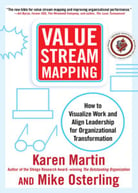
Continuous Improvement
6 min read
Book Club: "Value Stream Mapping" (part 2)

 The Dozuki book club is your go-to place for industry books and resources. Our team curates knowledge from industry experts, letting you identify key takeaways and start implementing solutions quickly.
Note: Last month we read Part 1 of “Value Stream Mapping.” Today we’ll be talking about designing the future state and how to develop a transformational plan.
The Dozuki book club is your go-to place for industry books and resources. Our team curates knowledge from industry experts, letting you identify key takeaways and start implementing solutions quickly.
Note: Last month we read Part 1 of “Value Stream Mapping.” Today we’ll be talking about designing the future state and how to develop a transformational plan.
Future State Design: Overview
Determining the “right work”
Delivering customer value without incurring unnecessary expenses.
- Removing processes and process steps - start by removing non-value-adding work.
- Don’t remove work just for the sake of removal, determine that it is truly unnecessary.
Adding processes and process steps
This step requires a holistic view of the organization and the value stream. Adding preventative tasks that reduce work further down the Value Stream (VS) can create work in a different department earlier on.
- Be weary of adding too many quality checks, which may create a bottleneck.
- Instead, focus on how to eliminate the need for a quality check in the first place.
Making Work Flow
After establishing what is the “right work,” consider how to make that work flow without delays or unnecessary effort.
- “Ideally, the team designs a future state that results in lower lead time, lower process time, and higher percent complete and accurate for every process block.”
What to do with Freed Capacity:
- Absorb additional work without increasing staff.
- Reduce paid overtime.
- Innovate; create new revenue streams.
- Conduct continuous improvement activities.
- Provide cross-training to create greater organizational flexibility.
- Slow down and think.
- Managing the Work
- Establish KPIs to determine if the value stream is performing well.
- Assign someone to monitor and manage value stream performance.
Future State Kickoff
- Review the charter as discussed in our previous post
- This will help remind the team of the target condition the new value stream should create.
- Review the current state findings
- This ensures that both the target state and the current state are fresh in the team’s mind.
- Introduce relevant countermeasures
- Avoid making large, sweeping changes - change takes time.
Create the Future State Value Stream Map
- After you have selected and prioritized your improvement ideas, it’s time for the team to document the future state design and make performance predictions.
- Follow similar design steps that were outlined in mapping the current state.
- Improvements are visually depicted by “kaizen bursts,” the irregular pointed icons.
- These describe what the improvements are, but not how to implement them.
Developing the Transformational Plan
The transformation plan is the executable action plan for making the improvements required to transform the current state to the future state.
Elements of the Transformational Plan Should Include:
- Scheduled review dates
- Have relevant parties meet regularly to assess progress.
- Measurable Target(s)
- Specific objectives that correlate to the countermeasures intended to improve processes.
- Proposed Countermeasures
- Improvements contained in the kaizen bursts - what needs to happen (not how).
- Execution Method
- The means by which improvements will be executed.
- Just-Do-Its
- Low-risk, quick improvements that don’t required extensive cross-functional involvement.
- Kaizen Events
- 2-5 day process improvement (PDSA) events.
- Planned Execution Timeline
- Final Briefing
- A final meeting to get approval and buying from leaders about the planned countermeasures.
- Managing the Transformation Plan
- Designate one party to be accountable for the success of the plan.
- Schedule regular review meetings with key stakeholders to evaluate the efficacy of the countermeasures.
- Designate one party to be accountable for the success of the plan.
Achieving and Maintaining Transformation
Socializing the maps and transformation plan
- Much like socializing the charter, people need to understand why changes are occurring and how they will be affected.
Executing Improvements
- This is the crux of the transformational plan, and the most difficult to follow through on.
- Stick with your plan and try not to deviate unless necessary.
- Don’t become too fixed in your plan that you ignore facts.
- Stick with your plan and try not to deviate unless necessary.
Transformation Plan Reviews
- Your plan should include defined dates to review progress.
- Track the progress of countermeasures.
- What unintended consequences have surfaced and how can they be addressed?
Sustaining Improvements
- An organization’s ability to sustain the improvements relies on the socializing the improvements and putting the right people in charge.
- Designate someone to monitor the improvements and their success.
- Establish KPIs to track success.
Continuous Improvement
- How often should value streams be improved? Continuously.
- Engage in value stream improvement activities with company leaders at least once a year.
Topic(s):
Continuous Improvement
Related Posts
View All Posts
Continuous Improvement
Book Club: "Value Stream Mapping" (Part 1)
9 min read
The Dozuki book club is your go-to place for industry books and resources. Our team curates knowledge from industry experts, letting you identify key takeaways and start...
Continue Reading
Continuous Improvement
Why Do Value Stream Mapping? | Benefits & Examples
22 min read
A successful business incorporates two critical factors, customers, and cost. The goal of any business is to provide the most outstanding value for the customer at the lowest
Continue Reading
Continuous Improvement
Understanding Value Streams with Karen Martin
6 min read
Employee on-boarding is often overlooked in the business world. We spoke with Karen Martin, author of "Value Stream Mapping" about why all supportive processes are equally...
Continue Reading


